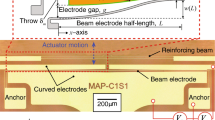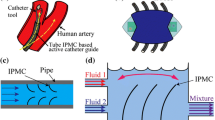Abstract
Curved electrode actuators displace on the order of a biological cell diameter at low actuation voltages, making them a potential candidate for probing and micromanipulation of cells in an underwater, closed microenvironment. Here, a closed microenvironment is formed by bonding a Polydimethylsiloxane-based cap-like structure to the actuator; however, the presence of Au/Cr conductive layers on the actuator reduce the available silicon surface area of the actuator—resulting in poor adhesion. Therefore, we propose to fabricate the actuators without these conductive layers. In this paper, we demonstrate the absence of these layers has a minimal effect on the actuator’s peak-to-peak displacement and force. The actuator achieves the following performance metrics: large displacement (1–10 μm) and force (1–21.5 μN) range; broad frequency range (1–500 Hz); and low actuation voltages (0–8 V) in viscous media that are necessary for cell probing and micromanipulation applications.








Similar content being viewed by others
References
Antoniolli F, Maggiolino S, Scuor N, Gallina P, Sbaizero O (2014) A novel MEMS device for the multidirectional mechanical stimulation of single cells: Preliminary results. Mech Mach Theory 78:131–140. https://doi.org/10.1016/j.mechmachtheory.2014.03.009
Bell DJ, Lu TJ, Fleck NA, Spearing SM (2005) MEMS actuators and sensors: observations on their performance and selection for purpose. J Micromech Microeng 15(7):S153–S164. https://doi.org/10.1088/0960-1317/15/7/022
Gajasinghe RWRL, Senveli SU, Rawal S, Williams A, Zheng A, Datar RH, Cote RJ, Tigli O (2014) Experimental study of PDMS bonding to various substrates for monolithic microfluidic applications. J Micromech Microeng 24(7):075010. https://doi.org/10.1088/0960-1317/24/7/075010
Hoelzle DJ, Chan CK, Scott MB, Lake MA, Rowat AC (2015) A large displacement, high frequency, underwater microelectromechanical systems actuator. J Appl Phys 117(1):014503. https://doi.org/10.1063/1.4905385
Hopcroft MA, Nix WD, Kenny TW (2010) What is the Young's Modulus of Silicon? J Microelectromech Syst 19(2):229–238
Legtenberg R, Gilbert J, Senturia SD, Elwenspoek M (1997) Electrostatic curved electrode actuators. J Microelectromech Syst 6(3):257–265. https://doi.org/10.1109/84.623115
Li J, Brenner MP, Christen T, Kotilainen MS, Lang JH, Slocum AH (2005) Deep-reactive ion-etched compliant starting zone electrostatic zipping actuators. J Microelectromech Syst 14(6):1283–1297. https://doi.org/10.1109/JMEMS.2005.851842
McDonald JC, Whitesides GM (2002) Poly(dimethylsiloxane) as a Material for Fabricating Microfluidic Devices. Acc Chem Res 35(7):491–499. https://doi.org/10.1021/ar010110q
Mukundan V, Pruitt BL (2009) MEMS Electrostatic Actuation in Conducting Biological Media. J Microelectromech Syst 18(2):405–413. https://doi.org/10.1109/JMEMS.2009.2013398
Mukundan V, Nelson WJ, Pruitt BL (2013) Microactuator device for integrated measurement of epithelium mechanics. Biomed Microdevices 15(1):117–123. https://doi.org/10.1007/s10544-012-9693-0
Mukundan V, Ponce P, Butterfield HE, Pruitt BL (2009) Modeling and characterization of electrostatic comb-drive actuators in conducting liquid media. J Micromech Microeng 19(6):1–9. https://doi.org/10.1088/0960-1317/19/6/065008
Osterberg PM, Senturia SD (1997) M-TEST: A test chip for MEMS material property measurement using electrostatically actuated test structures. J Microelectromech Syst 6(2):107–118. https://doi.org/10.1109/84.585788
Preetham BS, Lake MA, Hoelzle DJ (2017) Evaluation of curved electrode electrostatic actuator dynamics in viscous dielectric media for bioMEMS applications. Napa Microsystems Workshop 2017
Preetham BS, Lake MA, Hoelzle DJ (2017) A curved electrode electrostatic actuator designed for large displacement and force in an underwater environment. J Micromech Microeng 27(9):095009. https://doi.org/10.1088/1361-6439/aa7a47
Rowat A, Hoelzle D, Chan C (2014) Mechanical phenotyping of single cells: high throughput quantitative detection and sorting. WO Patent App. PCT/US2013/068,571
Scuor N, Gallina P, Panchawagh HV, Mahajan RL, Sbaizero O, Sergo V (2006) Design of a novel MEMS platform for the biaxial stimulation of living cells. Biomed Microdevices 8(3):239–246. https://doi.org/10.1007/s10544-006-8268-3
Shao CY, Kawai Y, Esashi M, Ono T (2010) Electrostatic actuator probe with curved electrodes for time-of-flight scanning force microscopy. Rev Sci Instrum 81(8):083702. https://doi.org/10.1063/1.3469796
Sounart TL, Michalske TA, Zavadil KR (2005) Frequency-dependent electrostatic actuation in microfluidic MEMS. J Microelectromech Syst 14(1):125–133. https://doi.org/10.1109/JMEMS.2004.839006
Acknowledgements
The authors would like to thank David Hoelzle at The Ohio State University for granting access to research facilities to conduct experiments shown in this work. This work was supported in part by University of Notre Dame Walther Cancer Foundation IITP Fellowship, Wichita State, Notre Dame, and Ohio State capitalization funds. Technical consultation was given by the Notre Dame Nanofabrication and Ohio State Nanotech West Facilities.
Author information
Authors and Affiliations
Corresponding author
Appendix
Appendix
The curved electrode electrostatic actuator shown in Fig. 3 is fabricated on a silicon-on-glass (SOG) wafer with the physical parameters given in Table 1. The SOG wafers are fabricated (purchased from PlanOptik, Elsoff, Germany) by anodic bonding of a silicon wafer (<100> p-type boron doped to 100 ppm) to a 500 μm thick Borofloat33 glass wafer and then thinning and polishing the silicon wafer to a thickness of 45 μm. Components are micromachined from the silicon layer, while the glass layer acts as a handling substrate and provides optical access for viewing with an inverted microscope. The typical fabrication workflow is illustrated in steps (a) → (h) in Fig. 9, which results in the fabrication of the actuator with Au/Cr conductive layers that form electrode pads and tracks.
First, on the SOG wafer, a composite metal film comprising of 200 nm Au/30 nm Cr is deposited on the silicon side by e-beam evaporation and patterned by photolithography to make electrode pads and tracks (a, b). Next, an etch mask to be used for bulk micromachining of actuator components is defined by depositing a 1000 nm thick SiO2 layer using a plasma enhanced chemical vapor deposition (PECVD) process (processed at 250 °C using SiH4/N2O gases), patterned using a photoresist mask, and then etched using inductively coupled plasma assisted reactive ion etching process (RIE-ICP; using CHF3/Ar gases) (c, d). Then, the wafer is diced into 11 mm × 18 mm dies, each containing an actuator; dicing is an aggressive process and performing at this early stage of fabrication increases the yield, as the silicon layer is still monolithic. After dicing, the high-aspect ratio actuator features (curved electrodes, beam electrode, reinforcing beam) are machined by DRIE using a standard Bosch process in 5s:2s step cycles; the glass substrate acts as an etch stop (e). After DRIE, the movable structures of the actuator are released by timed HF (49% HF:H2O::1:1 volume ratio) wet etch process for 3 min at standard room temperature, triple rinsed in water, then in methanol, and then dried at room temperature (f). Next, the actuator is coated with 10 nm thick Al2O3 insulator film using atomic layer deposition (ALD) process (processed at 120 °C using TMA/O2 precursors) (g). Finally, the 10 nm thick Al2O3 insulator film is anisotropically etched using inductively coupled plasma assisted reactive ion etching process (RIE-ICP; using BCl3/Cl2 gases) to unmask the Au/Cr electrode pads that were coated with Al2O3 during the ALD process (h); the anisotropic etch does not appreciably effect Al2O3 on the sidewalls. This completes the typical fabrication approach.
To study the effect of not having the Au/Cr conductive layers, we wet etch the Au/Cr layers using corresponding etchants (i). This completes the fabrication process of the actuator (without conductive layers) used in the study.
Fabrication scheme of the actuator. Steps (a) → (h) are the traditional steps in the fabrication. Actuators from step (h) have conductive layers and are used for benchmarking purposes. To study the effect of not having the Au/Cr conductive layers, we fabricate the actuators by wet etching the Au/Cr layers using respective wet etchants [step (i)].
Rights and permissions
About this article
Cite this article
Burugupally, S., Mangels, J.A. Performance evaluation of a curved electrode actuator fabricated without gold/chromium conductive layers. Microsyst Technol 24, 3479–3485 (2018). https://doi.org/10.1007/s00542-018-3751-3
Received:
Accepted:
Published:
Issue Date:
DOI: https://doi.org/10.1007/s00542-018-3751-3





